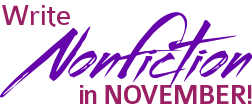Dengue & Me
 Ever since I first heard about NaNoWriMo in the late 90s from a friend whose nephew was doing it, I wanted to give it a try. It seemed like an incredible undertaking, and for a while I didn’t think I was writer enough to do it. But finally, I decided to go for it. Even though I never considered myself a fiction writer, I fancied I could write a mystery. I succeed in writing 50,00 words of pure junk that year, and though it was terrible stuff, I felt a huge sense of accomplishment.
Ever since I first heard about NaNoWriMo in the late 90s from a friend whose nephew was doing it, I wanted to give it a try. It seemed like an incredible undertaking, and for a while I didn’t think I was writer enough to do it. But finally, I decided to go for it. Even though I never considered myself a fiction writer, I fancied I could write a mystery. I succeed in writing 50,00 words of pure junk that year, and though it was terrible stuff, I felt a huge sense of accomplishment.
The next year, I decided to try it again. Only this time, I was going to make it more practical. I was working on a non-fiction book about women inventors, and I had a lot of interview material. I decided I’d use the month to shape the material. It wasn’t the same as generating 1600 words a day, but figured that if I could enter and edit that many words a day, I was in sync with the intent. Again, I finished the month with 50,000 words logged, but didn’t have the same sense of accomplishment. even though I had a nice early draft that book. After that, decided to be a bystander in November, watching and cheering for friends who were doing NaNo. It simply didn’t fit my style of crafting a piece of writing.
In early October of this year, I was getting ready for a trip in Todos Santos, Mexico, where I would housesit for my brother and spend two weeks working on shaping my third book. I had collected mountains of interview transcriptions, and I wanted to begin to organize the material. I’d purchased Scrivener and taken an online class from Gwen Hernandez, the author of Scrivener for Dummies. I was anxious to start using what I’d learned while depositing material into a Scrivener Project I’d set up for the book. Somewhere along the line while I was getting stuff together, I came across a site developed by Nina Amir, called Write Non-Fiction In November.
I was excited. This was more in keeping with what I needed than NaNoWroMi. I signed up for Nina’s newsletter and registered for WNFIN. As soon as I got to Mexico, I logged into the forum and introduced myself and my project and explained that I needed a few days to decide on what my goals would be for the month. Then I got busy playing around with my material and Scrivener.
The first few days were not fun. It felt chaotic and I had no idea how I was going to manage the girth of material I had collected. But I paid attention to the advice from one of Nina’s email messages. She recommended visualizing myself succeeding, so I developed a mantra: “I’m making progress on the Borgquist project!” and I repeated it all day long, especially when I got discouraged. Pretty soon a plan emerged.
I discovered that I could open a transcription file and as I read through it, I could copy/paste segments into documents I’d set up in Scrivener that were loosely based on my subject’s lifeline. With this discovery, I established my first goal for WNFIN: I would spend a minimum of 2 hours a day doing this activity. Of course, as I worked. I started to discover holes in the material, so I was keeping a running list of people to call and questions that needed answering. That shaped my second goal: Spend 4-6 hours a week in research mode, calling people, doing interviews or locating facts. My third goal was the real carrot. At least once a week, I would spend up to 4 hours actually writing, that is actually shaping it into a narrative. Since this is the fun part of the project for me, it made sense to give some time to it to keep my spirits high.
I thrilled to be joining folks around the world who have dedicated significant time in November to their writing projects, be it NaNo or WNFIN. And I’m especially thrilled to have found a community of writers who are working on non-fiction writing like me.
Not sure what motivates others to dive into and make progress in a project, but I love to sign-up and measure my progress toward a writing goal in association with HUGE online community.What about you?
 Twilightme.
Twilightme.